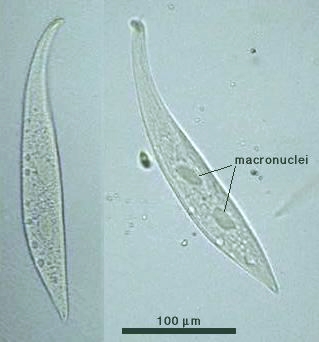

Litostomatea:
Haptoria: Pleurostomatida: Amphileptidae
Amphileptus meleagris
Ehrenberg, 1830
Syn.: Hemiophrys Wrzesniowski, 1870
 Genus: Flask-shaped; ciliation uniform and complete; slit-like cytostome not reaching the middle of body,
without trichocyst-borders; two or more macronuclei (Kudo, 1966).
Many contractile vacuoles along both dorsal and ventral edges (Carey, 1992).
Genus: Flask-shaped; ciliation uniform and complete; slit-like cytostome not reaching the middle of body,
without trichocyst-borders; two or more macronuclei (Kudo, 1966).
Many contractile vacuoles along both dorsal and ventral edges (Carey, 1992).
Species: Cell body 200-300 μm long (Kahl, 1931).
|
Amphileptus meleagris,
cell body 287 μm long, 19 μm wide,
two ellipsoidal macronuclei, 26 μm long, 10 μm wide,
trichocysts in the buccal region and also scattered throughout cytoplasm,
a single contractile vacuole located at the posterior end,
with a lateral row of 8 or more contractile vacuoles,
x 200, x 400, Japan, 1997 by Y. Tsukii
 100 μm
100 μm
 200 μm
200 μm
 300 μm; x 200
300 μm; x 200


 50 μm
50 μm
 100 μm
100 μm
 150 μm; x 400
150 μm; x 400


* A. lanceolatus Dragesco, 1965): lanceolate in form; 120 μm long;
pointed both anteriorly and posteriorly; no elongate neck region; trichocysts in the buccal region and also
scattered throughout cytoplasm; mucocysts present; a macronucleus consisting of two spherical bodies with a
intercalated micronuleus; a single contractile vacuole with satellite vacuoles (Carey, 1992).
A. inquieta (Biernacka, 1963): 170-200 μm long; with an elongate neck & rounded
posterior; a row of four contractile vacuoles present laterally; two large spherical
macronuclei (Carey, 1992).
Please click on images for viewing enlarged.
Copyright
Protist Information Server
 Genus: Flask-shaped; ciliation uniform and complete; slit-like cytostome not reaching the middle of body,
without trichocyst-borders; two or more macronuclei (Kudo, 1966).
Many contractile vacuoles along both dorsal and ventral edges (Carey, 1992).
Genus: Flask-shaped; ciliation uniform and complete; slit-like cytostome not reaching the middle of body,
without trichocyst-borders; two or more macronuclei (Kudo, 1966).
Many contractile vacuoles along both dorsal and ventral edges (Carey, 1992).



